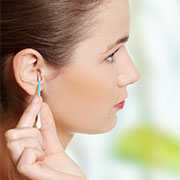Earwax (cerumen) is a yellowish waxy material produced inside the ear.
It is slightly acidic and has antibacterial properties (due principally to the presence of saturated fatty acids, lysozyme, and pH typically around 6,1).
Cerumen is produced in the ear canal. It is composed of a mixture of viscous secretions from sebaceous glands and less viscous secretions from apocrine sweat glands. There are two genetically determined types of earwax: the wet one (dominant, moist, rich in lipids and pigment granules) and the dry one (recessive, flaky). What’s interesting, Asians and native Americans are more likely to have the dry type of earwax, while European and African people are more likely to have the wet one.
Earwax doesn’t usually cause problems. However, too much earwax can lead to a blocked and painful ear and/or hearing loss. Movements of the jaw help the ears’ natural cleaning process, but sometimes they are not sufficient and earwax removal is necessary.
Treatment usually starts with eardrops to soften the cerumen, which becomes easier to remove. Cerumenolysis is achieved using a cerumenolytic agent. Its application (repeated two or three times a day for three to five days) causes the plug to soften. It usually makes the wax come out, but even if it doesn’t, it facilitates removal by syringing or curettage. Eardrops should not be used if you have a perforated eardrum.
If your earwax blockage persists even after using eardrops, ear irrigation may be recommended. It involves using a spray type ear washer (in the medical setting) or a syringe (usually at home). The procedure should be stopped if you are feeling pain, dizziness, vertigo, or if you’re experiencing a hearing loss. These symptoms may be the result of an ear infection. Ear irrigation is not recommended if you have previously had problems with irrigation, if you have had a perforated eardrum in the last twelve months, otitis media in the last six weeks, acute otitis externa, a grommet or a cleft palate (whether repaired or not).
Earwax may be also removed with a curette (ear pick). It scoops the earwax out of the ear canal. The procedure should be proceeded only by health professionals.
EXCERCISE
(Choose TRUE or FALSE)
1. Earwax is produced in middle ear.
2. Native Americans usually have the wet type of earwax.
3. Earwax usually causes health problems.
4. Cerumenolysis facilitates the earwax removal.
5. Curettage can be easily proceeded at home.
• earwax [ˈɪərwæks] – woskowina uszna
• cerumen [sɪˈrumən] – woskowina uszna
• lubrication [lubrɪˈkeɪʃən] – nawilżanie, natłuszczanie
• to repel [tə rɪˈpɛl] – odpychać, odrzucać
• viscous [ˈvɪskəs] – lepki, kleisty
• sebaceous gland [sɪˈbeɪʃəs glænd] – gruczoł łojowy
• plug [plʌg] – korek, zatyczka
• apocrine sweat gland [ˈæpəkrɪn swɛt glænd] – apokrynowy gruczoł potowy
• flaky [ˈfleɪki] – łuskowaty, płatkowaty, łuszczący się
• to facilitate [tə fəˈsɪlɪteɪt] – ułatwiać
• to syringe [tə səˈrɪndʒ] – przepłukiwać strzykawką
• syringe [səˈrɪndʒ] – strzykawka
• curettage [kyʊərɪˈtɑʒ] – łyżeczkowanie, wyskrobywanie
• moist [mɔɪst] – mokry, wilgotny
• perforated eardrum [ˈpɜrfəreɪtɪd ˈɪərdrʌm] – perforacja błony bębenkowej
• vertigo [ˈvɜrtɪgoʊ] – zawrót głowy
• grommet [ˈgrɒmɪt] – dren śródbębenkowy
• cleft palate [klɛft ˈpælɪt] – rozszczep podniebienia
• curette [kyʊˈrɛt] – skrobak, łyżeczka
• to scoop [tə skup] – wygarniać, wydłubywać
Correct answers:
false, false, false, true, false
Nikt nie pyta Cię o zdanie, weź udział w Teście Zaufania!
To 5 najczęściej kupowanych leków na grypę i przeziębienie. Pokazujemy je w kolejności alfabetycznej.
ASPIRIN C/BAYER | FERVEX | GRIPEX | IBUPROM | THERAFLU
Do którego z nich masz zaufanie? Prosimy, oceń wszystkie.
Dziękujemy za Twoją opinię.


